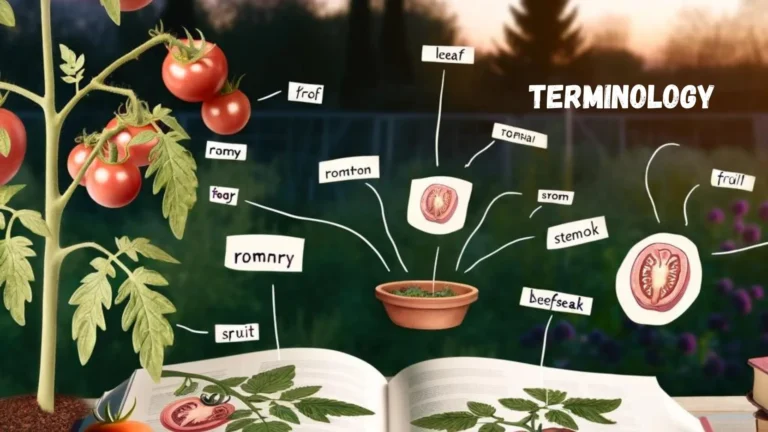The tomato terms below offer a helpful guide to the most important variety characteristics, growing requirements, and disease-resistance traits to consider when selecting tomatoes for your garden.
Whether you’re looking for compact bushes, vine indeterminates, or colorful heirlooms, this tomato glossary outlines key factors that will help match specific tomato types with your garden’s unique conditions and climate.
Factors like mature plant size, disease resistance, fruit shape, season length, and flavor profiles are detailed here so you can make informed decisions when browsing seed catalogs and plant nurseries.
You’ll be rewarded with a bountiful, healthy tomato crop that thrives in your region with the right variety selection. Use this list as a quick reference for deciphering tomato terminology and identifying well-suited varieties for a successful harvest.
In This Article
Tomato Terminology/Tomato Glossary
Tomato Terminology (List A)
- Anthers – The pollen-producing part of the flower’s stamen.
- Anthocyanins – The pigments that give tomatoes their red, purple, or black colors.
- Apex – The pointed tip end of the tomato fruit opposite the stem end.
- Apex Rot – Infection at the blossom end of the fruit causing rot.
Tomato Terminology (List B)
- Beefsteak – A type of tomato rather than a variety (although there is a particular variety named ‘Beefsteak’). Usually considered a large, irregularly shaped tomato with solid flesh.
- Blanching – Tying leaves around stems/fruits to protect from sun-scald.
- Blossom End Rot – A calcium deficiency disorder causing black leathery patches on the bottom of the fruit.
- Bolting – Producing flowers/seeds prematurely due to stress.
- Brad’s Atomic Grape – Popular miniature purple grape tomato variety.
- Brandywine – Famous heirloom beefsteak tomato known for its rich flavor.
- Brix – Measurement of sugar content in tomatoes using a refractometer.
Tomato Terminology (List C)
- Calyx – Green sepals form a cup around the tomato flower and attach the fruit to the stem.
- Campari – A popular commercial cocktail/salad tomato hybrid known for sweetness.
- Catface – Deformed tomato fruit with abnormal swelling and scarring.
- Cherry Tomato – Small round tomato varieties typically under 2 inches in diameter.
- Commercial Heirlooms – Open-pollinated varieties were introduced before 1940.
- Compost Tea – Organic foliar spray made by steeping compost in water.
- Cordon – The training method involves a single stem tied to a support.
- Corking – Cracked, cork-like patches on tomato skin that don’t affect quality.
- Cosmic Eclipse – Unique black tomato cultivar with green stripes when ripe.
- Cotyledons – The first leaves formed from the seed.
- Crack Resistant – A tomato is inherently resistant to cracking, a problem usually caused when rain falls sporadically or excessively rain.
- Created Heirlooms – Crossing two known parents (either two heirlooms or an heirloom and a hybrid) and dehybridizing the resulting seeds for however many years/generations it takes to eliminate the undesirable characteristics and stabilize the desired characteristics, perhaps as many as 8 years or more.
- Cross-Pollination – Transfer of pollen between two different plant varieties.
- Cultivar – The variety of a plant. However, technically, there is a difference between cultivar and variety. Cultivar is considered a product of intentional breeding, whereas variety is the product of accidental crossing. The terms are commonly used interchangeably.
- Curly Top Virus – Viral disease stunts plants and curls leaf margins upward.
Tomato Terminology (List D)
- Damping Off – Fungal disease killing seedlings at the soil line.
- Determinate – Tomato varieties with limited vine growth reaching a determined height and width.
- Dicot – Plants with two seed leaves or cotyledons. Tomatoes are dicots.
- Drip Irrigation – A watering method delivered slowly at the soil level.
- Drip Tape – Perforated tubing drips water slowly at the base of plants.
Tomato Terminology (List E)
- Early Blight – Fungal leaf spot disease favored by wet conditions.
- Early Girl – Very popular compact determinate tomato variety.
Tomato Terminology (List F)
- Family Heirlooms – Seeds passed down for several generations through a family.
- Fermentation – Anaerobic breakdown of organic matter by bacteria/microbes.
- Fingerling – Elongated, oval heirloom tomato varieties.
- Flavor – Combination of sugars, acids, and aromatic volatile compounds influencing taste.
- Foliar Feeding – Applying liquid fertilizer directly to plant leaves.
- Fusarium Wilt – Soil-borne fungal disease that causes wilting.
Tomato Terminology (List G)
- Genetically Modified Organism (GMO) – Organisms whose genes have been artificially manipulated.
- Globe – A round-shaped tomato.
- Grafting – Joining the top of one plant (scion) to the roots of another (rootstock).
- Green Shoulders – Green spots on the ripening tomato near the stem.
- Green Zebra – Green tomato with yellow stripes when immature, ripening to amber.
- Growing Degree Days – Measurement of heat accumulation affecting crop growth.
Tomato Terminology (List H)
- Hand Pollination – Using a brush or electric vibrator to pollinate flowers.
- Hardiness – A plant’s ability to withstand cold temperatures.
- Heirloom – An heirloom is generally considered a variety passed down through several generations of a family because of its valued characteristics. Since ‘heirloom’ varieties have become popular in the past few years, liberties have been taken with this term’s use for commercial purposes. Heirloom tomato experts Craig LeHoullier and Carolyn Male, Ph. have classified heirlooms into four categories:
- Commercial Heirlooms: Open-pollinated varieties were introduced before 1940.
- Family Heirlooms: Seeds passed down for several generations through a family.
- Created Heirlooms: Crossing two known parents (either two heirlooms or an heirloom and a hybrid) and dehybridizing the resulting seeds for however many years/generations it takes to eliminate the undesirable characteristics and stabilize the desired characteristics, perhaps as many as 8 years or more.
- Mystery Heirlooms: Varieties that are a product of natural cross-pollination of other heirloom varieties.Note: All heirloom varieties are open-pollinated, but not all open-pollinated varieties are heirloom varieties.
- High Wire Cordon – Training single-stemmed tomatoes on high wires.
- Hornworm – Large green caterpillar that damages tomato plants.
- Hybrid Pollination – Cross-pollination is accomplished by removing anthers of parent X before the release of pollen. Parent Y’s anther tube is opened, and pollen is removed to deposit on the stigma of parent X.
- Hybrid Vigor – Increased growth, production, and uniformity in hybrid offspring.
Tomato Terminology (List I)
- Indeterminate – Tomato varieties that grow and produce fruit continuously.
Tomato Terminology (List K)
- Kelp Extract – Seaweed product used as organic foliar fertilizer.
Tomato Terminology (List L)
- Leggy – Weak, floppy seedlings due to lack of light.
- Locules – Chambers within the tomato’s fruit that hold the seeds within a jelly-like substance. Most fruits have 2 or more chambers, and large-fruited varieties have as many as 10.
- Lycopersicon esculentum – The genus and species name for the tomato. All plants have a genus and species name, indicated in italics.
- Lycopene – Red carotenoid pigment and powerful antioxidant in tomatoes.
Tomato Terminology (List M)
- Marglobe – Early disease-resistant globe tomato variety developed in 1917.
- Maturity – The number of days from transplanting the seedling to the first mature fruit. Early-season varieties generally mature between 55 to 68 days; midseason varieties between 69 to 79 days; late-season varieties 80 days and beyond.
- Micro-Tom – Extremely compact tomato variety grown in containers.
- Moisture Meter – Device that measures water content in the soil.
- Mosquito Dunks – A floating product with BTI to control fungus gnat larvae.
- Mulch – Material like straw or plastic sheeting used to cover soil.
- Mystery Heirlooms – Varieties that are a product of natural cross-pollination of other heirloom varieties.
Tomato Terminology (List N)
- Nematodes – Microscopic worms in the soil, some beneficial, some parasitic.
- Northern Exposure – Disease-resistant determinate tomato bred for cooler climates.
Tomato Terminology (List O)
- Oblate – A slightly flattened round shape of a tomato.
- Open-Pollinated – Seeds from open-pollinated varieties produce plants and fruit identical to their parent. Note: All heirloom varieties are open-pollinated, but not all open-pollinated varieties are heirloom varieties.
- Oxheart – Heart-shaped heirloom tomatoes noted for sparse seed cavities.
Tomato Terminology (List P)
- Pericarp – The wall of the tomato fruit that encloses seeds and pulp.
- Personal Favorite – A variety that has been a favorite through years of growing.
- pH – Scale measuring acidity or alkalinity of growing media.
- Phytophthora – Destructive soil-borne fungus causing blight diseases.
- Pith – The inner core of tomato fruit containing the seeds.
- Pollen – Powdery grains containing the male DNA of flowers.
- Pollination – Transfer of pollen from male anthers to female stigma, allowing fertilization.
- Potato-Leaf – Foliage without indentations on leaf margins. Looks similar to the leaves of a potato plant.
- Pruning – Selective removal of leaves, stems, or suckers to shape plants.
Tomato Terminology (List R)
- Radial Cracks – Star-shaped cracks on top of tomatoes.
- Regular-Leaf – Foliage with indentations on the leaf margins.
- Rutgers – Popular midseason globe tomato developed in 1934.
Tomato Terminology (List S)
- San Marzano – Elongated paste tomatoes popular for sauce and canning.
- Self-Pollination – Pollen transfer from anther to stigma within the same flower.
- Self-Pollinating – When pollen from a flower pollinates the same flower.
- Semi-Determinate – Tomato plants are larger than determinate (bush types) but smaller than indeterminate plants. These plants usually require staking.
- Sepals – Small leafy structures protecting unopened flower buds.
- Sideshooting – Pruning off suckers in leaf axils between the main stem and branches.
- Silking – Emergence of elongated yellow stigma from tomato flower.
- Staking – Providing physical support for plants using stakes and ties.
- Stigma – The female part of a flower that receives pollen.
- Suckers – New shoots growing in leaf axils between the main stem and branches.
- Sunscald – Burning damage to fruit from too much sun exposure.
Tomato Terminology (List T)
- Tobacco Mosaic Virus – Viral pathogen causing mottling and mosaic patterns.
- Topping – Removing growing tips to halt upward growth.
- Transplanting – Moving seedlings from starter containers into the garden.
- Trellis – Framework used to support climbing tomato vines.
- Trellising – Training plants on a support system like strings, cages, and poles.
- Truss – Cluster of tomatoes all attached to a single stem.
Tomato Terminology (List V)
- Variety – Plants within a species with minor differences but can interbreed.
- Verticillium Wilt – Fungal disease infects the xylem and causes wilting.
- Virus – Infectious particles transmitted by insects/tools causing mottling/damage.



